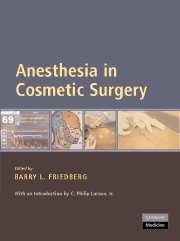Book contents
- Frontmatter
- Contents
- Foreword
- Acknowledgments
- Introduction
- Preface
- List of Contributors
- PART I MINIMALLY INVASIVE ANESTHESIA (MIA)Ⓡ FOR MINIMALLY INVASIVE SURGERY
- 1 Propofol Ketamine with Bispectral Index (BIS) Monitoring
- 2 Preoperative Instructions and Intraoperative Environment
- 3 Level-of-Consciousness Monitoring
- 4 The Dissociative Effect and Preemptive Analgesia
- 5 Special Needs of Cosmetic Dental Patients
- 6 Propofol Ketamine in the UK, Propofol Ketamine Beyond Cosmetic Surgery
- 7 Propofol Ketamine Beyond Cosmetic Surgery: Implications for Military Medicine and Mass-Casualty Anesthesia
- 8 Lidocaine Use and Toxicity in Cosmetic Surgery
- 9 Local Anesthetic Blocks in Head and Neck Surgery
- 10 Local Anesthetics and Surgical Considerations for Body Contouring
- PART II ALTERNATIVE ANESTHESIA APPROACHES IN COSMETIC SURGERY
- PART III OTHER CONSIDERATIONS FOR ANESTHESIA IN COSMETIC SURGERY
- APPENDIX A A Guide to Perioperative Nutrition
- APPENDIX B Reflections on Thirty Years as an Expert Witness
- Index
- References
5 - Special Needs of Cosmetic Dental Patients
from PART I - MINIMALLY INVASIVE ANESTHESIA (MIA)Ⓡ FOR MINIMALLY INVASIVE SURGERY
Published online by Cambridge University Press: 22 August 2009
- Frontmatter
- Contents
- Foreword
- Acknowledgments
- Introduction
- Preface
- List of Contributors
- PART I MINIMALLY INVASIVE ANESTHESIA (MIA)Ⓡ FOR MINIMALLY INVASIVE SURGERY
- 1 Propofol Ketamine with Bispectral Index (BIS) Monitoring
- 2 Preoperative Instructions and Intraoperative Environment
- 3 Level-of-Consciousness Monitoring
- 4 The Dissociative Effect and Preemptive Analgesia
- 5 Special Needs of Cosmetic Dental Patients
- 6 Propofol Ketamine in the UK, Propofol Ketamine Beyond Cosmetic Surgery
- 7 Propofol Ketamine Beyond Cosmetic Surgery: Implications for Military Medicine and Mass-Casualty Anesthesia
- 8 Lidocaine Use and Toxicity in Cosmetic Surgery
- 9 Local Anesthetic Blocks in Head and Neck Surgery
- 10 Local Anesthetics and Surgical Considerations for Body Contouring
- PART II ALTERNATIVE ANESTHESIA APPROACHES IN COSMETIC SURGERY
- PART III OTHER CONSIDERATIONS FOR ANESTHESIA IN COSMETIC SURGERY
- APPENDIX A A Guide to Perioperative Nutrition
- APPENDIX B Reflections on Thirty Years as an Expert Witness
- Index
- References
Summary
INTRODUCTION
Cosmetic dental procedures are increasing. Americans have demonstrated their interest in cosmetic medical procedures through their interest in television features, documentaries, and “reality” programming. This programming often features dental procedures ranging from reconstructive maxillofacial surgery through complex dental restorative procedures to simple cosmetic teeth bleaching. Modern dental practice offers many treatment solutions to almost any patient need or desire. Some of these procedures require highly technical and precise care to produce a desirable outcome. The dentist must obtain near-perfectconditions in an otherwise hostile environment.
The primary operating area, a person's mouth, is a small, dark, wet hole with plenty of very delicate, moving parts (see Fig. 5-1). An ill-timedtwitch or swallow, a hiccup or sigh, a startled wince and a big problem has been created. Further, in all cases, the treatment objects—tooth, periodontal tissue, dentoalveolar ridge—are tiny. For example, a coronary artery being grafted during coronary artery bypass surgery (CABG) is usually more than 5 millimeters in diameter whereas the distance from the outside of a front tooth to the pulp (nerve) is less than half that.
Modern dentistry is truly powerful. Many cosmetic and restorative treatment options are available from dentists in all parts of the country. Ceramic or polymer laminates (veneers) and crowns can be attached to teeth or titanium implants placed in the bone allowing a fixed, permanent correction for lost, damaged, or irregularly placed teeth.
- Type
- Chapter
- Information
- Anesthesia in Cosmetic Surgery , pp. 47 - 58Publisher: Cambridge University PressPrint publication year: 2007



